Zn2+-dependent deoxyribozymes that form natural and unnatural RNA linkages
- PMID: 15966746
- PMCID: PMC1586068
- DOI: 10.1021/bi050146g
Zn2+-dependent deoxyribozymes that form natural and unnatural RNA linkages
Abstract
We report Zn(2+)-dependent deoxyribozymes that ligate RNA. The DNA enzymes were identified by in vitro selection and ligate RNA with k(obs) up to 0.5 min(-)(1) at 1 mM Zn(2+) and 23 degrees C, pH 7.9, which is substantially faster than our previously reported Mg(2+)-dependent deoxyribozymes. Each new Zn(2+)-dependent deoxyribozyme mediates the reaction of a specific nucleophile on one RNA substrate with a 2',3'-cyclic phosphate on a second RNA substrate. Some of the Zn(2+)-dependent deoxyribozymes create native 3'-5' RNA linkages (with k(obs) up to 0.02 min(-)(1)), whereas all of our previous Mg(2+)-dependent deoxyribozymes that use a 2',3'-cyclic phosphate create non-native 2'-5' RNA linkages. On this basis, Zn(2+)-dependent deoxyribozymes have promise for synthesis of native 3'-5'-linked RNA using 2',3'-cyclic phosphate RNA substrates, although these particular Zn(2+)-dependent deoxyribozymes are likely not useful for this practical application. Some of the new Zn(2+)-dependent deoxyribozymes instead create non-native 2'-5' linkages, just like their Mg(2+) counterparts. Unexpectedly, other Zn(2+)-dependent deoxyribozymes synthesize one of three unnatural linkages that are formed upon the reaction of an RNA nucleophile other than a 5'-hydroxyl group. Two of these unnatural linkages are the 3'-2' and 2'-2' linear junctions created when the 2'-hydroxyl of the 5'-terminal guanosine of one RNA substrate attacks the 2',3'-cyclic phosphate of the second RNA substrate. The third unnatural linkage is a branched RNA that results from attack of a specific internal 2'-hydroxyl of one RNA substrate at the 2',3'-cyclic phosphate. When compared with the consistent creation of 2'-5' linkages by Mg(2+)-dependent ligation, formation of this variety of RNA ligation products by Zn(2+)-dependent deoxyribozymes highlights the versatility of transition metals such as Zn(2+) for mediating nucleic acid catalysis.
Figures

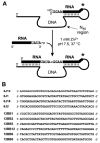
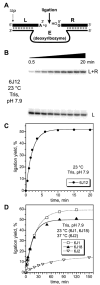
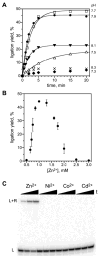


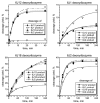
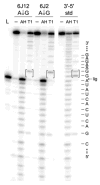
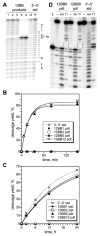

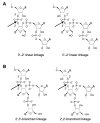
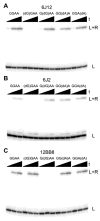
Similar articles
-
Rational modification of a selection strategy leads to deoxyribozymes that create native 3'-5' RNA linkages.J Am Chem Soc. 2004 Dec 22;126(50):16426-32. doi: 10.1021/ja045817x. J Am Chem Soc. 2004. PMID: 15600344
-
Controlling the direction of site-selectivity and regioselectivity in RNA ligation by Zn2+-dependent deoxyribozymes that use 2',3'-cyclic phosphate RNA substrates.Org Biomol Chem. 2008 Dec 7;6(23):4391-8. doi: 10.1039/b813566e. Epub 2008 Oct 27. Org Biomol Chem. 2008. PMID: 19005599 Free PMC article.
-
Parallel selections in vitro reveal a preference for 2'-5' RNA ligation upon deoxyribozyme-mediated opening of a 2',3'-cyclic phosphate.J Mol Evol. 2005 Aug;61(2):207-15. doi: 10.1007/s00239-004-0326-y. Epub 2005 Jun 30. J Mol Evol. 2005. PMID: 16007488
-
In vitro selection, characterization, and application of deoxyribozymes that cleave RNA.Nucleic Acids Res. 2005 Nov 11;33(19):6151-63. doi: 10.1093/nar/gki930. Print 2005. Nucleic Acids Res. 2005. PMID: 16286368 Free PMC article. Review.
-
Deoxyribozymes: selection design and serendipity in the development of DNA catalysts.Acc Chem Res. 2009 Oct 20;42(10):1521-31. doi: 10.1021/ar900052y. Acc Chem Res. 2009. PMID: 19572701 Free PMC article. Review.
Cited by
-
On the origin of life in the zinc world: 1. Photosynthesizing, porous edifices built of hydrothermally precipitated zinc sulfide as cradles of life on Earth.Biol Direct. 2009 Aug 24;4:26. doi: 10.1186/1745-6150-4-26. Biol Direct. 2009. PMID: 19703272 Free PMC article.
-
Generation of RNA with 2', 3'-Cyclic Phosphates by Deoxyribozyme Cleavage in Frozen Solutions.Methods Mol Biol. 2022;2439:301-309. doi: 10.1007/978-1-0716-2047-2_19. Methods Mol Biol. 2022. PMID: 35226329
-
The importance of peripheral sequences in determining the metal selectivity of an in vitro-selected Co(2+) -dependent DNAzyme.Chembiochem. 2012 Feb 13;13(3):381-91. doi: 10.1002/cbic.201100724. Epub 2012 Jan 17. Chembiochem. 2012. PMID: 22250000 Free PMC article.
-
A deoxyribozyme that synthesizes 2',5'-branched RNA with any branch-site nucleotide.Nucleic Acids Res. 2005 Jun 20;33(11):3503-12. doi: 10.1093/nar/gki656. Print 2005. Nucleic Acids Res. 2005. PMID: 15967808 Free PMC article.
-
Lanthanide ions as required cofactors for DNA catalysts.Chem Sci. 2012;3(5):1707-1714. doi: 10.1039/C2SC01067D. Epub 2012 Mar 1. Chem Sci. 2012. PMID: 23243490 Free PMC article.
References
-
- Kruger K, Grabowski PJ, Zaug AJ, Sands J, Gottschling DE, Cech TR. Self-splicing RNA: autoexcision and autocyclization of the ribosomal RNA intervening sequence of Tetrahymena. Cell. 1982;31:147–157. - PubMed
-
- Cech TR. Self-splicing of group I introns. Annu Rev Biochem. 1990;59:543–568. - PubMed
-
- Qin PZ, Pyle AM. The architectural organization and mechanistic function of group II intron structural elements. Curr Opin Struct Biol. 1998;8:301–308. - PubMed
-
- Guerrier-Takada C, Gardiner K, Marsh T, Pace N, Altman S. The RNA moiety of ribonuclease P is the catalytic subunit of the enzyme. Cell. 1983;35:849–857. - PubMed
-
- Breaker RR. DNA enzymes. Nature Biotechnol. 1997;15:427–431. - PubMed
Publication types
MeSH terms
Substances
Grants and funding
LinkOut - more resources
Full Text Sources
Miscellaneous

